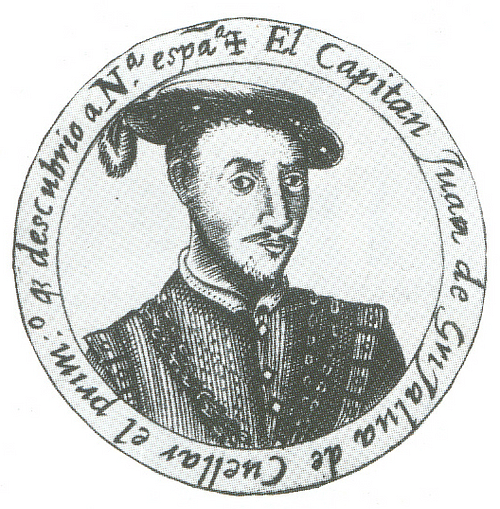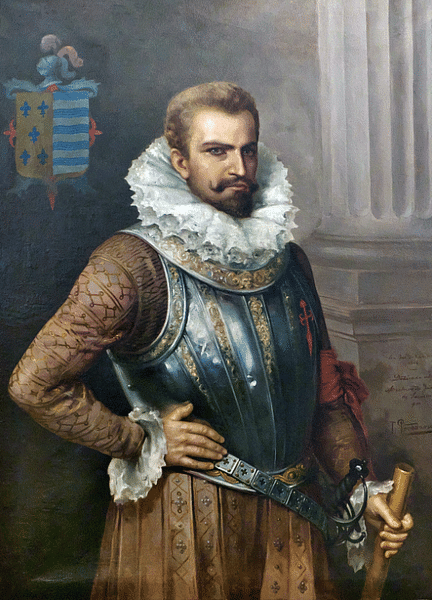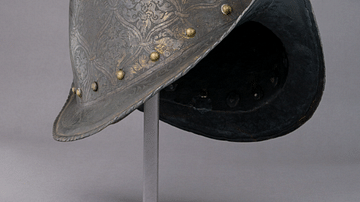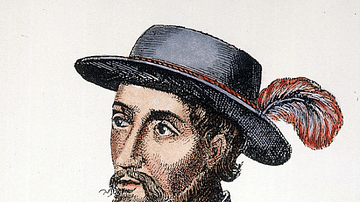
Juan de Grijalva (aka Grijalba, 1489-1527) was a Spanish conquistador who explored the eastern coast of Mexico in 1518. His notable achievements included a demonstration that the Yucatán Peninsula was just that and not, as previously thought, an island. Grijalva's expedition acquired through trade certain items made of gold, and these two discoveries encouraged the Spanish to send further expeditions to the American mainland.
From Cuba to Mexico
Juan de Grijalva was born in Cuellar, Segovia, Spain, in 1489. His uncle was Diego Velázquez de Cuéllar (1465-1524), the Spanish conquistador who conquered Cuba in 1511 and who then became the island's first governor for the next decade. Grijalva had participated in the conquest of the island, and he received as a reward an encomienda, that is the right to use local forced labour to work his land.
Velázquez then sponsored expeditions to explore and exploit the American mainland, and for the second such enterprise, Grijalva was selected as its leader. His brief was to land on the coast of what is today Mexico and explore inland. Velázquez's first expedition, sent in 1517 and led by Francisco Hernández de Córdoba (1474-1517), had sent back a promising report of the Yucatán peninsula, but he and most of his party had been killed in a battle with the Maya (Córdoba survived to return to Cuba but died of his injuries). Clearly, Grijalva must expect resistance as he pressed deeper into the jungles of this unknown territory, then still thought to be an island like the rest of the Spanish conquests had been in the Caribbean.
Grijalva's expedition fleet left Cuba on 8 April 1518. He commanded 200-240 men in four ships. Two useful expedition members were Mayans taken hostage by Córdoba in 1517 to act as interpreters; their names (given by the Spanish) were Julian and Melchior. Another noted member of the group, this time a Spaniard, was Bernal Díaz de Castillo (1492 to c. 1580), who was then a mere ensign. Díaz later wrote his famous account, The Conquest of New Spain (1568). However, Díaz's occasional inconsistency with points of geography regarding Grijalva's expedition has led some historians to doubt his presence on it. Díaz did, though, devote an entire chapter of his book to the expedition which he describes in detail. Díaz also records that, in his opinion, Grijalva "was always a courageous man with all the qualities of a brave and bold leader" (39).
Grijalva's expedition was much bigger and better equipped than Córdoba's, a notable addition being several cannons. These gunpowder weapons were used to terrorise the Maya, who had never seen such things before. Although the cannons were of the smaller falconet type – they could only fire projectiles with accuracy at a target some 135 metres (450 ft) distant – the noise and smoke were effective weapons in themselves. Other useful arms carried by the conquistadors included muskets and crossbows. These would be used against peoples armed with bows, lances, swords, and slings.
The Yucatán Peninsula
The expedition first stopped for resupply on the island of Cozumel on the eastern side of the Yucatán Peninsula. This island would become a frequently-used stepping stone for future conquistador expeditions. The historian F. Cervantes describes Cozumel's attractions, a taste of the Maya world that Grijalva and his men were about to intrude upon:
Cozumel was full of promise; the local honey was gloriously rich, and the fruits and vegetables were as exotic as they were wholesome. The bright colours of the birds were like nothing they had seen before, a suitable corollary to the comparative sophistication of the local inhabitants. Not only did they have 'books', as Peter Martyr would call the beautifully painted pictures smeared with bitumen and stretched upon long sheets made of bark, but they had also built a thatched temple on top of a tall pyramid where some intriguing idols were venerated. (122)
Rounding the tip of the peninsula, the expedition proceeded to sail westwards. Needing regular stops to take on fresh water because of their small ships, the expedition leap-frogged along the coast, landing at Campeche first and then Laguna de Términos in early May. One reason for caution was the lack of familiarity with these waters, as Díaz explains: "[We made] our way by day westward, close along the shore, but not daring to sail at night for fear of reefs and shallows" (31). In this way the expedition stopped at Putunchan, Coatzacoalcos, San Juan de Ulúa/Veracruz, Nautla, and finally Tampico and the Panuco River before turning back.

Battles, Bartering, & Bloody Sacrifices
When the expedition first landed near Campeche, north of modern-day Champotòn, they met the ferocious Maya who had already seen off the Spanish invaders the year before under Córdoba. The Maya were adept at guerrilla warfare, using the jungle and hit-and-run tactics. The Spaniards used their cannons to good effect in this confrontation but, nevertheless, suffered a number of fatalities, and over 60 men were injured. In addition, Díaz notes: "Grijalva received three arrow wounds and had two of his teeth broken" (30). The conquistadors drove the Maya back into the swamps inland and continued their progress along the coast.
At the mouth of the Tabasco River, now called the Grijalva River after its 'discoverer', a fleet of 50 Maya canoes packed with armed warriors came out to meet the Spaniards. Using the interpreters, a conflict was avoided, and goods were traded. A few gold items like statuettes, diadems, and necklaces were acquired, but when pressed for more, the Maya told the conquistadors they had none to give but they would find more gold further along the coast. This alternation of battles with peaceful trade became a pattern of the expedition.

The fleet encountered several islands, and on one of these, Isla Verde, they found evidence of human sacrifice, later used as one of the primary justifications for the Christian conquest of the Americas:
The boats were then launched, and Juan de Grijalva with many of us soldiers launched to inspect this island, for we saw smoke rising from it. We found two stone buildings of good workmanship, each with a flight of steps leading up to a kind of altar, and on those altars were evil-looking idols, which were their gods. Here we found five Indians who had been sacrificed to them on that very night. Their chests had been struck open and their arms and thighs cut off, and the walls of these buildings were covered with blood. All this amazed us greatly, and we called this island the Isla de Sacrificios. (37)
The expedition reached the southernmost point of the Gulf of Mexico at Coatzalcoas and then proceeded to sail northwest, following the coastline up and finally landing at Veracruz. There, relations with the local people were more peaceful, and goods (notably 2,000 green glass beads) were traded for fine cotton cloth and some worked gold pieces. They named the island outside Veracruz San Juan de Ulúa because the day of discovery was that saint's day in the calendar and because the locals had ordered a human sacrifice on the island of two young boys, explaining this was on the orders of "Culhua" (see below), which was corrupted by the interpreter to "ulua". San Juan de Ulúa-Veracruz would later become one of the most important treasure ports of the Spanish Main, where galleon treasure fleets sailed for Spain and the Manila galleons landed from the Spanish Philippines.
Grijalva then continued to sail up the coastline, making landfall again at Panuco at the mouth of the river of that name, the furthest point north of the expedition. With the winter rains coming on, provisions running out, and one ship having a bad leak, it was decided to turn back for home. The expedition, after five months of exploration, finally returned to Santiago de Cuba, but Velázquez had already sent out a third expedition in February 1519 to search for Grijalva, a large affair commanded by one Hernán Cortés (1485-1547). Velázquez would sorely regret his choice since Cortés far exceeded his search and reconnaissance orders and went renegade, ultimately conquering the Aztec civilization without any official backing for such an ambitious enterprise.
Velázquez's Disappointment
Back in Cuba, Grijalva reported to Velázquez that Mexico was no island but part of a great landmass. Even better, Grijalva described the large ancient stone monuments he had seen, surely an indication that a great empire had been and perhaps still was present in this part of the New World. Intercourse with indigenous peoples revealed to the Spaniards rumours of a great civilization to the west, one led by a wealthy ruler known as "Lord of Culhua". We now know that the Aztec ruler Motecuhzoma II (aka Montezuma, r. 1502-1520) included this name amongst his lengthy list of honorific titles and that he had learnt of the Spaniards' first landing from messengers. To substantiate the rumours, there were even gold objects acquired through trade and duly grabbed by the conquistadors. Some of these gifts had actually been sent by Motecuhzoma to the foreign invaders in the rather foolish hope they would be satisfied with them and promptly disappear for good. Grijalva was rebuked by his uncle for not bringing back more of these precious items, as the conquistador's thirst for gold was greatly piqued.
Unfortunately for Grijalva, his personal situation was in decline just as that of the region was rising in Spanish estimates. During his 1518 expedition, Grijalva had made an enemy of one of his more troublesome conquistadors, Pedro de Alvarado (c. 1485-1541). Competition between the cutthroat conquistadors was far from being unusual, and Alvarado would later prove himself to be one of the cruellest and most sadistic of his type. Alvarado had captained one of the expedition ships and upset Grijalva when he had gone off once to explore a river without permission. In turn, Alvarado denounced Grijalva to Velázquez, which may well explain, along with his uncle's disappointment in the paucity of gold he brought back from Mexico, Grijalva's absence from the exploration limelight for the next few years.
Later Expeditions & Death
Grijalva was back in command of an expedition, or at least the naval part of it, in 1525. While Francisco de Garay, governor of Jamaica, led a land force into the area around Pánuco, Grijalva followed along the coast with a fleet of 12 ships. The expedition was a failure as the Europeans dwindled away in the appalling conditions of the mosquito-infested jungle. Grijalva continued to explore, this time in the opposite direction and down into Central America, but he was killed in what is today Honduras in January 1527. His son, Rodrigo de Girjalva, was also a conquistador, notably assisting Francisco Pizarro (c. 1478-1541) in his conquest of Peru in 1536.







